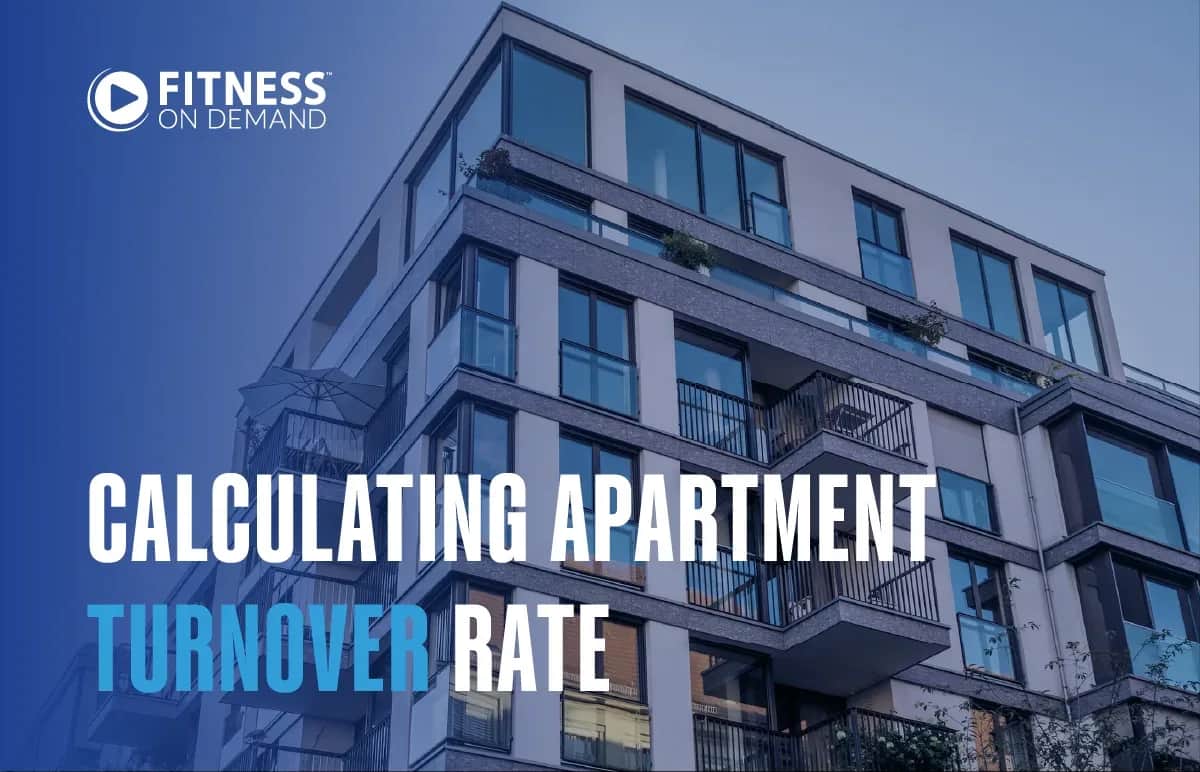As a property owner or community manager, your apartment turnover rate is nonexistent, you have people lined up for the next available unit, and your tenants are as close as the cast of Friends — right? No?

As a property owner or community manager, your apartment turnover rate is nonexistent, you have people lined up for the next available unit, and your tenants are as close as the cast of Friends — right? No?
If the idea of losing tenants is keeping you up at night, you might be relieved to know that there are quite a few things you can do to prevent apartment turnover costs and their associated expenses. Learn how to create a plan to foster a sense of engagement and community — while minimizing turnover — with the following guide.
Understanding Apartment Turnover
Apartment turnover refers to the number of people moving out of your buildings when their lease term is finished (or before). Ideally, you'd have potential tenants lined up to take the empty apartment, but that may not always be the case. Minimizing empty apartments is the goal here. Understanding your turnover rate is crucial to growing your income from any property.
Importance of Tracking Turnover Rates
Following your property's metrics — including tracking rates of turnover — is crucial to understanding whether your management style is effective. It can also help you predict whether your business is doing well, backsliding, or in danger of losing even more tenants in the future. Several factors, such as offering high-quality amenities and taking feedback from tenants in stride, can swing the balance in your favor.
A tenant moving out can cost you more than just the missed cost of rent for a few months. Consider these frequently overlooked expenses of the turnover process:
- Cleaning the unit, including possible repainting and re-carpeting
- Fixing damage that the previous tenant's deposit didn't cover
- Advertising the unit to prospective tenants
- Paying for utilities while the unit is vacant
- Spending time looking through applications and screening new tenants for income, compatibility, and trustworthiness
Now, imagine that you have three or four vacant rental units. As you can guess (or maybe you don't have to, if you're already facing this situation), these turnover costs can quickly add up and may total anywhere from $1,000 to $5,000. It's often better to think ahead and spend the money and time keeping your tenants in their units rather than scrambling to cover costs after they've left.
How to Calculate Apartment Turnover Rate: Formula and Examples
The first step in fixing your turnover rate is understanding whether you've got a problem. Are more tenants moving out than you expected? Are you unsure about how many people have moved out within the past year because things have been so busy?
Or, perhaps you're not a numbers person in general and you tend to leave the calculations to others. The rental turnover rate is pretty easy to calculate: just divide the number of residents who have moved out in a calendar year by the total number of residents in your complex, and then multiply it by 100.
For example, if five out of 50 tenants have moved out over the past year, you're looking at a ratio of 5/50*100. Since 5/50 gives you 0.1, you would then multiply 0.1x100. This leaves you with 10. In this scenario, your apartment turnover rate is 10%.
Data Collection for Accurate Calculations
To determine your turnover rate for a particular building, it's helpful to look at each year as a whole. Comparing months could be useful, but if, for example, you live in an area with a large student population, you may see more tenants vacating at the end of the school year. This uneven data could skew your results.
Comparing 2024 to 2023, and 2023 to 2022, will give you a better picture of whether your current implementations are working well. If they're not, it might be time to change strategies.
What Is the Typical Turnover Rate for Apartments?
In the past few years, the national average apartment retention rate, which refers to the tenants who stay in their apartments, has hovered between 50-58%. This indicates an average apartment turnover rate of 42-50%. In general, experts recommend trying to keep your retention rate around 40% or higher. This number will ebb and flow over time, so there's typically no need to worry if one year is 3% higher or lower than another.
The housing market can play a role in this turnover, too; for example, in areas where people usually buy houses after a couple of years of living in an apartment, tenants may move out sooner than those in areas where people tend to rent for decades at a time.
Strategies to Minimize Tenant Turnover
You likely understand that resident retention can save you a lot of money. Here are a few ideas for keeping your tenants happy where they are and incentivizing staying in their apartments.
Enhancing Property Management Practices
A few practical implementations can make your property management more effective. For example, these strategies can save time and clear your schedule for more pressing matters:
- Having a dedicated email or communication platform for residents
- Keeping your website and current vacancies up-to-date
- Automating bills and payments
- Combining your residents' utilities with their rent statements
In addition to keeping tabs on their budget and apartment turnover rate calculation, good property managers are forward-thinking. What are your residents' biggest issues living in your rental properties? How long do most tenants stick around? Ask yourself these questions and be open to the answers.
Fostering a Sense of Community
It's easy to feel disconnected and lonely in a crowd of people — or an apartment building full of strangers. Plan community engagement events such as movie nights, workout classes, or even speed dating sessions. Depending on your tenants' demographics, you could pull from a wide variety of activities. If you're unsure, try asking your tenants which types of activities they'd find the most enjoyable or enriching.
Ready to Create a Vibrant Community?
Bring residents together and boost your community engagement with a range of over 1,200 virtual health and wellness experiences that get your residents involved and connected.
Building Strong Relationships With Tenants
The stereotype of a distant, irritable landlord should be left in the past. Get to know your tenants by communicating effectively about the property rules and expectations, showing friendliness and personability when engaging with them, and respecting their space and privacy.
Offering Lease Renewal Incentives
Everybody likes a good deal — especially when it comes to rent. Offering lease renewal incentives may give your tenants a reason to stick around longer instead of finding a new place to live. Here are just a few examples:
- Discounts on rent or utilities. Offering discounts on signing a new lease or bundling discounted utilities with rent might be attractive offers for tenants who would otherwise look for another place to live.
- Flexible lease options. Though it sounds counterintuitive, offering flexible, or shorter, lease terms can pay off by retaining tenants. Current tenants may feel unsure about signing another year-long lease — especially, for example, if they're considering buying a house within the next year or so — but they may be willing to sign a six-month lease or pay month-to-month after the first year.
- Upgraded fixtures or amenities. Nobody wants to live in an outdated apartment. If you delay replacing old microwaves, stoves, or washing machines because of the expense, this might end up costing you more in the long run when your tenants start searching for a newer, nicer home.
- Safety upgrades. Offering upgrades such as covered parking and smart locks to communicate to your tenants that their safety matters to you.
- Pet policy changes. Many people look for places for themselves as well as their four-legged friends — but some apartment complexes only offer leases to potential tenants who have two dogs (but not three) or small dogs (but not certain breeds of larger canines). Relaxing your pet restrictions or judging potential pets on a case-by-case basis, can make your complex more tenant-friendly and contribute to a decrease your apartment turnover rates.
Leveraging Technology and Upgrading Amenities
Offering top-notch technology and exclusive amenities is a popular and effective strategy for attracting and retaining tenants. Consider the benefits of complexes that can offer high-speed internet, security cameras, smart temperature controls, or keyless entry to the building (or to the units themselves). As we move toward an increasingly high-tech society, including these perks in your rental packages could decrease your average tenant turnover rate.
Many residents appreciate community events and fitness classes that can provide a much-needed outlet for stress and a gathering place for those looking for a sense of community. The more classes you can offer, the better. It's often easier to provide virtual offerings due to the availability of the programming, the wide variety, and the ability to tackle various fitness goals that can apply to just about anyone's lifestyle.
Analyzing Tenant Feedback
Receiving feedback can be tough regardless of your profession. However, when the most successful landlords and building owners take stock of what's working — and what's not — they're setting the stage for a much lower apartment turnover rate.
How Fitness on Demand Can Help Incentivize Lease Renewals
While there's no guarantee that your tenants will become best pals who spend their entire lives in your building, offering practical, exclusive amenities can go a long way to keeping them happy, minimizing your average turnover rate, and stabilizing your rental income over time.
Fitness On Demand offers exciting, always-available virtual fitness classes that make room for exercise opportunities within the comfort of your tenants' homes. Get in touch with us to request a demo to determine the best way forward and start minimizing your apartment turnover rate today!

Author
Sean Obregon
Sean Obregon is an impactful Business Development Executive forming meaningful relationships to support enhancing operational and strategic success. He utilizes his industry knowledge and experience to create solutions that align with both the needs and wants of a customer, setting a business up for success.
